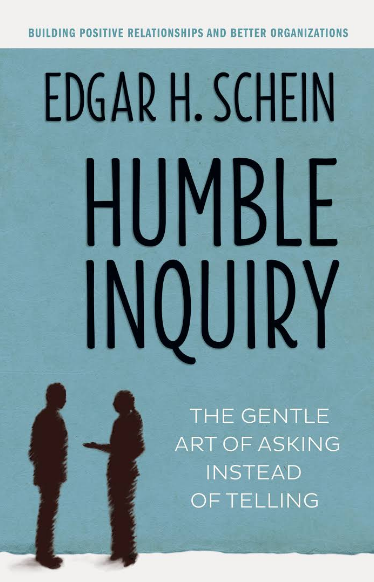humble inquiry
As I mentioned in my previous post I am moving to a new school….. this book has revolutionized every aspect of what I hope to achieve as we create positive change and consolidate on what works….. together. Especially, as we look more closely at the culture of the school.
There are many different personalities with different leadership qualities and styles. While a true leader may have to bend depending on the context, person/people or situation there should always be at least one thing that grounds your approach. I believe it is ‘The gentle art of asking instead of telling’ which should be something we attempt to develop as our craft.
For most of us we work in and with an inquiry curriculum, we need to also inquire too. The people we work with are just as important as the students we teach. They are! If we truly want the best out of people telling them will not create mutual respect or trust for open communication and collaboration. Asking builds relationships. Not only does asking build relationships, but it sharpens our IQ and EQ on what type of questions to ask which invite open dialogue.
Humble inquiry is intended to illustrate an attitude or provide specific questions that show interest and respect, which will stimulate more truth telling and collaboration. Humble inquiry is not a checklist to follow or a set of written questions – it is behaviors that comes out of respect, genuine curiosity, and the desire to improve the quality of the conversation by stimulating greater openness and sharing.
To put some of these ideas and approaches into action I am going to experiment with this by conducting a humble inquiry into who we are as a school and to mark a point on where we are in place and time as a school as we set goals and connect to our vision and mission. To take it a little further, I hope to use all the 6 transdisciplinary themes and through observations, conversations and humble inquiry I hope to gain a clear insight into who we are as a school with fresh eyes. If what I notice is the same as what people see and feel, then we have an opportunity to challenge, learn and plan ideas to implement change or improve on what we are already doing. This should make people feel part of the process, encourage opinion and amplify voice. I have no idea what this will reveal after such a process, but isn’t that the point of inquiry?
I will be using this to record the things I notice and hope to get teachers and students to also be part of this inquiry too. Let’s hope we can create the culture of listen first and then make sound decisions after with pure intentions to bring people together and help us be the best we can for our students and the people we work with and learn from.



Hi Chad, I think this is going to be a very interesting approach that will definitely reveal some very interesting information. I look forward to hearing more about it.
With my devil’s advocate hat on, I do think it’s worth considering how some teachers just want to be told what to do and what you expect and struggle with their response to an inquiry-based approach to leadership. In many cases, these are also the people who are unable to get genuine inquiry happening in their classrooms. They may quickly make judgments of you and accuse you of not being able to make decisions! Dealing with those people may take up a lot of your time and energy and you will have to find a way to get it all out in the open so it doesn’t fester and congeal into cliques and anti-leadership gossip. This has been a problem in all the schools I have worked in and visited, so finding an open, honest and respectful way to handle it would be very useful for people in lead ship positions worldwide… make sure you document and share your journey.
Yes, you’re right Sam!
The book goes on to talk about 4 forms of inquiry:
Humble inquiry
Diagnostic inquiry
Confrontational inquiry
Process-orientated inquiry
There are of course different outcomes yielded from each approach. Sometimes we may need to use a combination of these depending on what is needed and who best responds to that particular inquiry approach.
Best to start off with humble inquiry and then take inventory on how things are working or not. It will be documented, not sure how that will look yet.